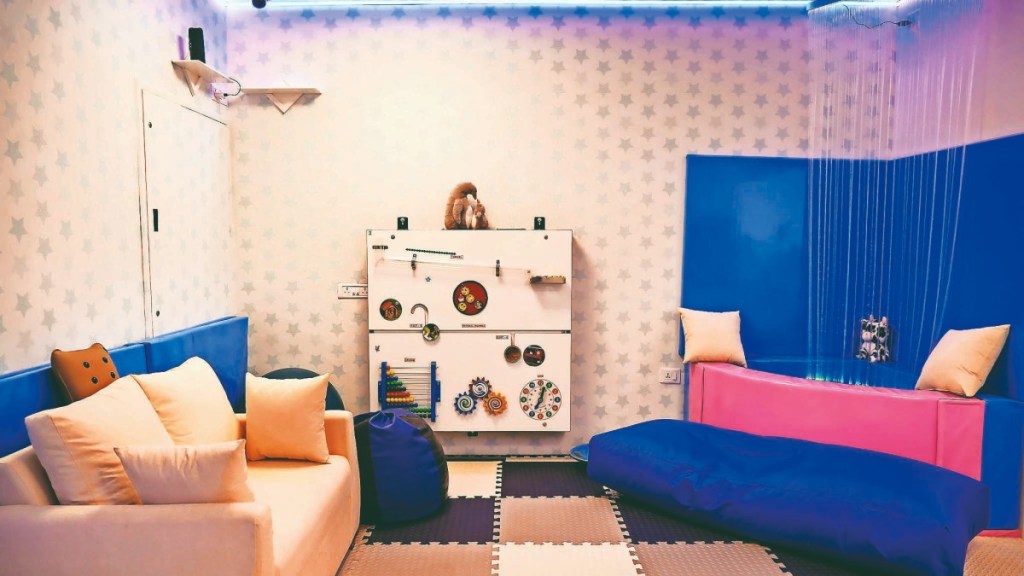Air travel can be overwhelming and stressful especially for the neurodiverse people. With bright lights, continuous announcements, security screenings, and crowded spaces – these factors that can be particularly challenging for individuals with autism spectrum disorder (ASD), sensory processing disorder (SPD), anxiety disorders, post-traumatic stress disorder (PTSD), and other sensory or mental health conditions.
But there’s always help at hand. Public spaces like stadiums and airports are equipped with sensory rooms to offer a calm, controlled space and to feel more at ease before the journey. Now, an airport in India is offering one too, with the country’s first sensory room at the Kempegowda International Airport, Bengaluru, that opened this month.
Looking at the history of sensory rooms, these date back to the Netherlands in the late 1970s, developed by psychologists Ad Verheul and Jan Hulsegge. Also called the snoezelen room, the name snoezelen comes from the fusion of the Dutch words snuffelen (to sniff) and doezelen (to doze or snooze). These rooms have a multi-sensory environment tailored to the specific needs of the individual, providing therapeutic benefits and promoting overall wellbeing, especially designed for neurodivergent passengers to offer calming experiences.
It is estimated that 15-20% of the global population has a neurological issue. While 79% of neurodivergent Indian travellers feel the available support meets their needs, Booking.com research shows that more than half (68%) still experience difficulties while travelling highlighting the need for better support, clearer communication and greater understanding.
Globally, many airports in the United States of America have sensory, quiet or yoga rooms across at places like Seattle, Kansas City, Boston Logan International Airport, Minneapolis Airport, Pittsburgh, Dublin where interactive spaces are designed to help travellers. San Francisco airport has also opened a similar facility open to everyone but designed specifically for travellers who are neurodiverse.
Seattle Airport created a space with a rocking chair, dim lighting and a starry night ceiling. Airport users who need a quiet space can visit prayer rooms at the Hong Kong International Airport. Dublin Airport, meanwhile, has built two sensory rooms. The Pittsburgh International Airport provides a quiet, peaceful spot for people with sensory sensibilities and their families.
The sensory room at Chase Centre in San Francisco has comfortable seating, carpeted walls, puzzles, and other sensory-soothing tools. The room at Madison Square Garden in New York City has adjustable lighting, artwork with bubbles, beanbag chairs, and tactile objects. There are two sensory rooms at the Sphere in Las Vegas, and both offer tactile toys.
Birmingham Airport in the UK has play zones and a lounge, while Gatwick Airport (UK) has a separate ‘interactive zone’ that stimulates the senses through tactile panels, textures and games to improve memory, learning and general motor skills.
In Germany, airports in Frankfurt and Munich offer sensory rooms or quiet spaces to help passengers feel more comfortable and less overwhelmed during their travel experience.
The FIFA World Cup Qatar in 2022 set up sensory rooms for fans at three Qatar stadiums: Al Bayt, Lusail and Education City. The spaces allowed fans to watch matches in a quieter space, equipped with assistive technology and managed by expert staff.
While an inclusive and passenger-friendly travel at the airport is important, Hari Marar, MD & CEO, Bangalore International Airport Limited (BIAL) says, “The addition of the sensory room aligns with our mission to create a seamless and stress-free experience for every traveller, ensuring that inclusivity is not just a feature but a core value for us.”
The BIAL sensory room is developed in collaboration with Incluzza, a thought leader in disability inclusion and powered by a not-for-profit EnAble India. Some of the key features include multiple ambient lighting sources, such as a bubble tube, galaxy projector, and LED cubes, which offer diverse sensory stimulation, encourage visual tracking, and allow personalised sensory input.
The art mural, with its organic abstract blobs, enhances emotional wellbeing through visually soothing patterns. Interactive elements like the floor and wall projections, ball pool, and sensory toy station are for cognitive engagement. Specialised items such as the crash pad, weighted blanket, and therapy mats aid in emotional regulation and relaxation. Visual and tactile features, including the optical curtain, infinity mirror, and tactile wall panels, encourage sensory exploration, while auditory elements like the white noise machine and sound system help create a consistent and calming atmosphere.
Additionally, there are features such as the balance board, lava lamp, and aroma diffuser that contribute to focus and stress reduction. The space is thoughtfully curated to cater to varying sensory needs, ensuring adaptability and inclusivity for all users. Through its combination of visual, tactile, auditory, and movement-based stimulation, the sensory room aims to serve as a haven for relaxation and self-regulation.









